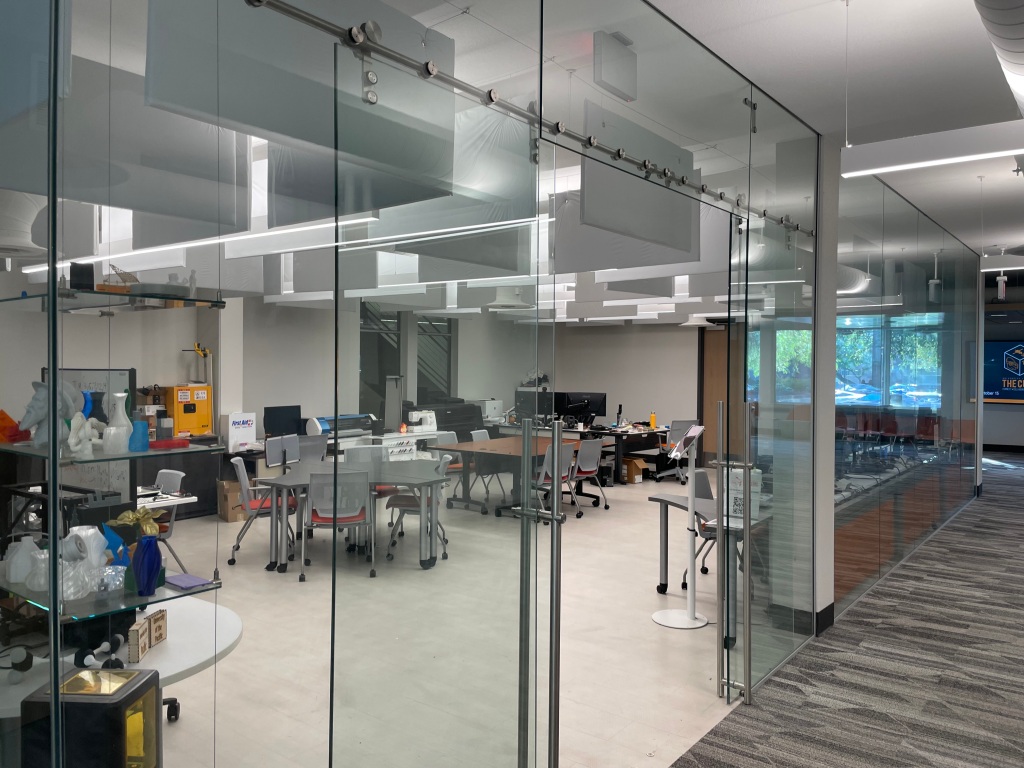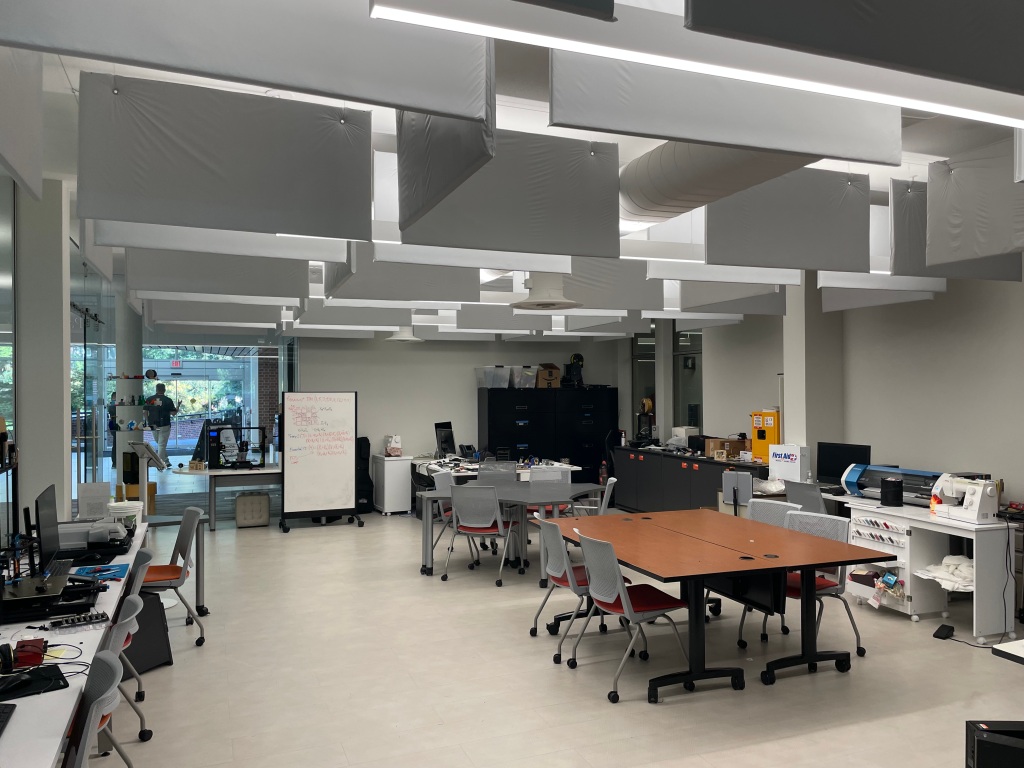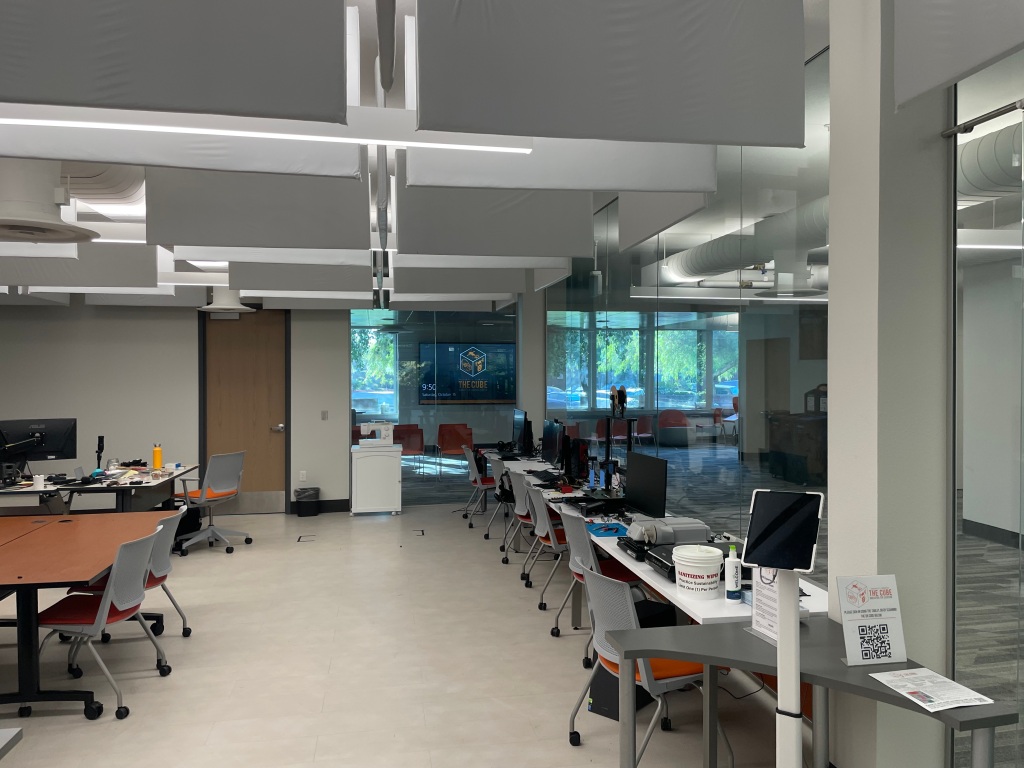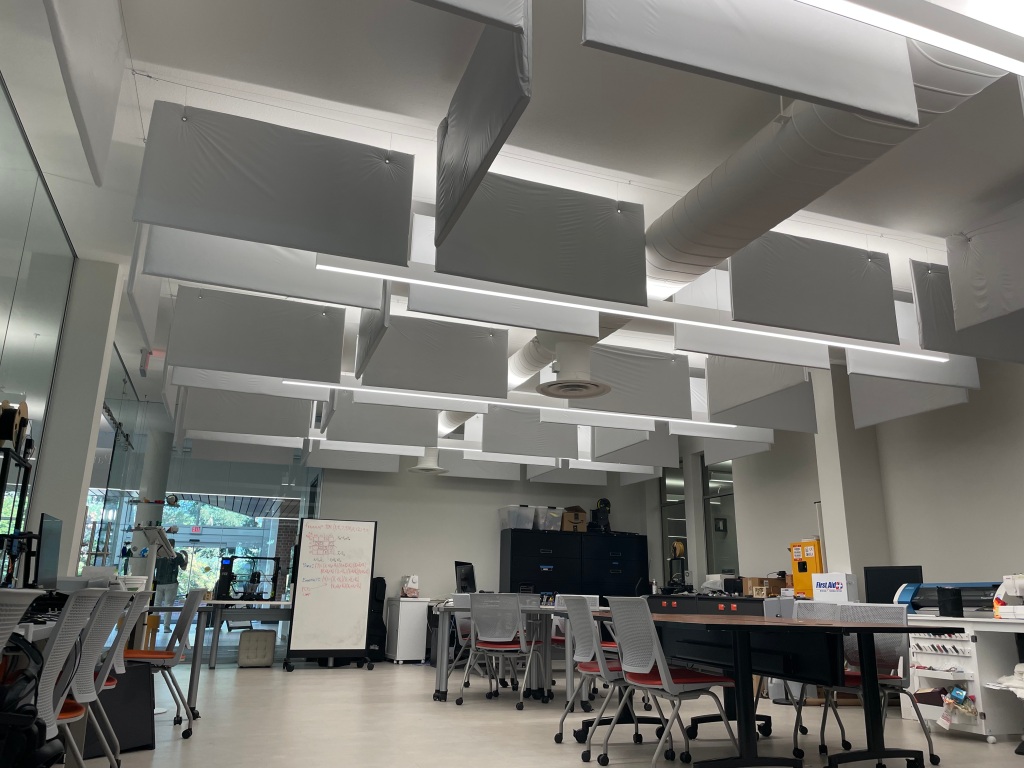Posts Tagged ceiling baffles
Taming the Cube with Cloudscape®
Posted byAcoustics FirstinAbsorption,Classrooms,Customer Feedback,Manufacturing,Media Room,开云体育手机版 ,School & Educational Facilities,Teaching Rooms,Universitieson October 21, 2022
When the University of the Pacific reached out to help tame the acoustics of their makerspace called “The Cube”, many different concerns were underlined about the space, its uses, and the problems they faced.

These concerns covered more than just the room dimensions – size, height, HVAC, glass walls, etc…. there were functional requirements for collaboration, classes, and workshops. The overwhelming acoustic problems involved the near constant noises generated by the vast array of equipment in this space – sewing machines, large format printers, plotting cutters, 3D printers, scanners, and every other modern tool for allowing the creative minds at their school to create. It was a cacophony of stepper motors, fans, and moving parts – which made collaboration very difficult.

The other parameter that needed to be maintained was the ability to reconfigure the layout of the equipment without affecting the acoustic treatment in the space. This removed almost all of the walls in the space as possible locations for treatment. This left the ceiling as the only viable space left for treatment, but with an array of lights and exposed HVAC systems, there were few treatments that would be easy to implement and still be effective.

The decision was made to creatively weaveCloudscape® Bafflesinto all the spaces available in the ceiling. Dodging duct-work and suspended lighting rails was made possible with careful planning and execution – and the results were immediately notable. (Also noticeable was that thebaffleshad very little impact on the lighting which is vital in any makerspace.)

“…The sound baffles you recommended finally got installed in my makerspace about two weeks ago and I wanted to send a quick thank you since they’ve made a very noticeable acoustic difference to the room, and it’s a lot more pleasant in here now. “
Chris Crawford – Innovation Spaces Manager (University of the Pacific)
FireFlex™ Wave – Cloud or Baffle
Posted byAcoustics FirstinAbsorption,开云体育手机版 ,Productson June 21, 2022
It’s good to have options in ceiling treatments. Some environments have high ceilings that benefit from vertically-hanging baffles, while other environments have lower ceilings in which clouds are more appropriate. In some cases the aesthetic will dictate which product would be best – but what if there was one product that could do both?

TheFireflex™ Wavehas a unique, undulating shape that adds visual interest along with acoustic absorption – but it has another feature which few materials can boast. Due to the Class 1(A) melamine foam construction, the corkscrew mounting hardware can be installed wherever it is needed – including on the edges.

By installing the hardware on the edges instead of the face, you are given the option to also hang theWavesin a vertical orientation as baffles. The wave shape works well aesthetically in either orientation – horizontal or vertical.
In rooms with a lower ceiling, the horizontal orientation of clouds provides more headroom while the undulating shape optimizes theWave’ssurface area for absorption. In larger spaces with high ceilings, you can add more absorptive surface area by hanging theWavesas baffles, and provide a more organic look than you get with flat baffles.
When overhead acoustic absorption is required, turn toAcoustics First®.
Boys & Girls Club is (Cloudscape®) Baffled!
Posted byAcoustics FirstinAbsorption,Customer Feedback,Fitness,Gymnasium,Multipurpose Rooms,开云体育手机版 ,Productson February 3, 2021
A large gymnasium/basketball court made of concrete blocks and metal is not an acoustically tame place. Add dozens of active boys and girls and the cacophony of sound can be a little overwhelming. This is exactly the reason why the Boys & Girls club reached out toAcoustics First®.
After a quick consultation, it was decided that the most efficient and cost effective option was installingCloudscape® bafflesto tame the overall reverb and sound pressure levels in the gym. Because thebafflesare hanging with all of the sides are exposed, this increases their effective surface area and, in turn, improves their ability to absorb noise. This efficiency, ease of installation, and their relatively low cost is why they were the perfect option for this space.
Reverberation, the Invisible Architecture
Posted byAcoustics FirstinAbsorption,Articles,Sound proofingon June 13, 2016

Cloudscape® BafflesandSonora® Panelschange the sonic architecture – making the space sound smaller and more intimate.
有没有想过是什么让我们的空间吗?自然sly, our eyes visually tell us what’s going on, but there are other senses that contribute. Peak your head into a dark front hall closet, and even without seeing much, you can “feel” the close proximity of the walls and perhaps even the presence of the coats. Walk in to New York’s Grand Central Station, and you are confronted by a completely different sensation. Close your eyes, and the raucous environment tells you are in a large room with a lofty ceiling. Often times we take for granted the relationship that sound has to our spatial perception.
This sonic “sense of space” can be generally attributed to the room’s reverberation qualities. In simple terms, reverberation is the sound energy that remains in the listening environment as a result of lingering reflections. Reverberation time (RT or RT60) quantifies how quickly an impulse sound decays in a space. RT60 is how quickly the amplitude (volume) of short exciting signal decreases by 60dB in a large room. Reverberation time is dependent upon the volume and surface materials of a given room. Large spaces with hard materials (tile, drywall, etc.) like Grand Central Station have longer reverberation times, while small rooms furnished with “softer” materials, like the coat closet, sound much more “dead”.
Excessive reverberation is one of the most common acoustic issues that we encounter on a daily basis. As you may have experienced at some point, it’s difficult to understand what is being said when reflections from old information cover up what is newly spoken. In spaces where speech intelligibility is paramount, like classrooms or conference rooms, a short reverberation time (under 1 second) should be targeted.
That said, sometimes a long reverberation time is desirable. In spaces like cathedrals and orchestral halls, reverberation helps create ambience for the audience by sustaining musical notes, while allowing choirs and orchestras to blend more easily. These spaces may lack a sound system, and instead utilize the room to propagate sound. Rock venues, on the other hand, have amplified instruments, so a medium-short reverb time is needed to ensure that the music won’t become “muddy” and difficult to perform and enjoy.
There are a number of questions that an acoustician must ask when recommending appropriate treatment. These questions include, but are not limited to: Is there live music in this room? What kind of music is being performed? Is speech intelligibly important? What’s the audience size and where are they in relation to the sound source? So, the ideal amount of reverberation in a space is wholly dependent on the use of the space.
Listed below are the ranges of “ideal” reverberation times at mid-frequency (average of 500 and 1000 Hz) for a variety of rooms. The numbers are derived from David Eagan’sArchitectural Acoustics(New York: McGraw-Hill, 1988), in which he breaks down rooms into Speech, Music and Speech/Music spaces. We hope you find this helpful.
Optimum Reverberation Times (T60)
“Speech” Rooms
Recording and Broadcasting Studio – .3 to .7 seconds
Classroom (elementary size) – .6 to .8 seconds
Conference/Lecture Room – .6 to 1.1 seconds
Intimate Drama – .9 to 1.1s“Speech & Music” Rooms
Cinema – .8 to 1.2 seconds
Small Theaters – 1.2 to 1.4 seconds
Multi-Purpose Auditoriums – 1.5 to 1.8 seconds
Worship Spaces – 1.4 (Churches) to 2+ seconds (Cathedrals)“Music” Rooms
Dance Clubs and Rock Venues (w/ Sound System) – 1 to 1.2 seconds
Semi classical Concerts/Chorus (w/ Sound System) – 1.2 to 1.6 seconds
交响音乐会(古典)- 1.6到2.3秒s
Liturgical (Organ/Chorus) – 2+ seconds
ContactAcoustics Firstto have our acousticians help you find the ideal reverb time for your space.
Yocumtown gets Peace and Quiet
Posted byAcoustics FirstinAbsorption,Customer Feedback,Gymnasium,Multipurpose Rooms,开云体育手机版 ,School & Educational Facilities,Theater,Worship Facilitieson May 14, 2014
Yocumtown Church of God had a bit of an issue with their multipurpose room – They couldn’t understand anything anyone was saying.
While the space was designed well with a full court, dampers on the HVAC, a stage, movie screen and a good speaker system – they couldn’t overcome the poor acoustics of the space. A great deal of work had gone into the design and they wanted an unobtrusive way to treat the acoustic problems… enter Acoustics First.
我们开始收集信息的工作the space; dimensions, some pictures and a few balloon pops.
Here’s what we got.
Wow! This room is big, all the surfaces are parallel and hard, there’s very little to break up the sound… You can almost imagine what it sounds like.
You actually don’t need to imagine. Here’s a balloon pop.CLICK HERE!
What you’re hearing is about 3.5 seconds of reverberation after the balloon pop. (Not good.)
So, whatever shall we do? How will we tame this space?!?!?! Will they ever be able to have movies for youth groups!?
Sure they will! We have Joe. You remember Joe from theSabot School Big Room Big Boom Post?
Well, I would say that Joe has a 6th sense for hearing, but since that’s one of the 5 standard ones anyway, we’ll just say Joe has great ears – and they should be. Joe’s been using his ears as his primary tools for the past 40+ years; from Studio Engineer to Acoustic Engineer. His ears are tuned instruments, and we rely on his expertise with them to get the job done right – time and time again. (He also makes a mean spreadsheet.)
So after listening to the room, looking at the data, and running some numbers – Joe magically answers the question of what do they need? (Ok it isn’t magic – Joe’s just really good at this… did I mention his spreadsheet skills?)
So Joe says, “You put 280 – 4’x1′Cloudscape®bafflesup on that ceiling and you’ll bring that room down from about 3.5 seconds to about 1.5 seconds.”
Joe knows.
So, Yocumtown goes from a 3.5 second balloon pop (Here) to a 1.5 second balloon pop (Here).
Not only does it look great…
… But now they say that they can watch movies and it sounds just like you’re in a movie theater.
That’s about the best compliment you can give us.
(And the best compliment I can give Joe is, his calculation for RT60 time was about 1.5 seconds. When I ran the measurement of the “treated balloon pop” – I got 1.501 seconds. This is why we have Joe – he can tell you what you will get, before you even start!)




You must belogged into post a comment.